Vintage Clubs and Unbridled Swings: Redefining the Love of Golf with a Journey Back in Time at Olivas Links
For three months, I had a singular focus. My mission was to beat a crew of weekend golfers in a match play contest dubbed “The Highlander.” Golf evolved from a light-hearted hobby into a no-frills, all-or-nothing contest. Soon, my two-handicap was an albatross hanging around my neck and every score above par a scarlet letter. My identity and self-worth fluctuated from hole to hole. Things boiled over during a practice round. After two fat shots, I flung my sand wedge at my golf bag, collapsing the legs like Jean Van de Velde at Carnoustie. The regret was immediate, but the obsession persisted. The pursuit for self-affirmation eventually ended in a 7 & 5 loss in the championship round. The theme of the day was mopiness, accompanied by six bogeys, a double, and a soundtrack of grunts and moans.
Troy, a long-driving slasher who looks every bit the former hockey player that he is, witnessed the downward spiral. He observed the tonal shift in my approach to golf and quietly remained supportive. Although passive, he was prepared for the impending collision between unreasonable expectations and probable outcomes. I received a lifeline after the defeat. Troy sent a text message reading, “Want to play our retro clubs tomorrow for fun?” There was something about that word: “fun.” The definition was simple — something that provides amusement or enjoyment — but the concept felt strangely distant. What did fun and golf have to do with each other anymore?
It was an intriguing experiment: What would happen if we took sets of clubs, both of which we’ve never played, to the same course as the prior day’s disaster. Absent experience with the clubs’ yardage, flight, or spin rates, anything was possible. At minimum, it felt like an opportunity to instill wonder into an exercise that had become predictable and stale. I replied with an emphatic, “YES.”
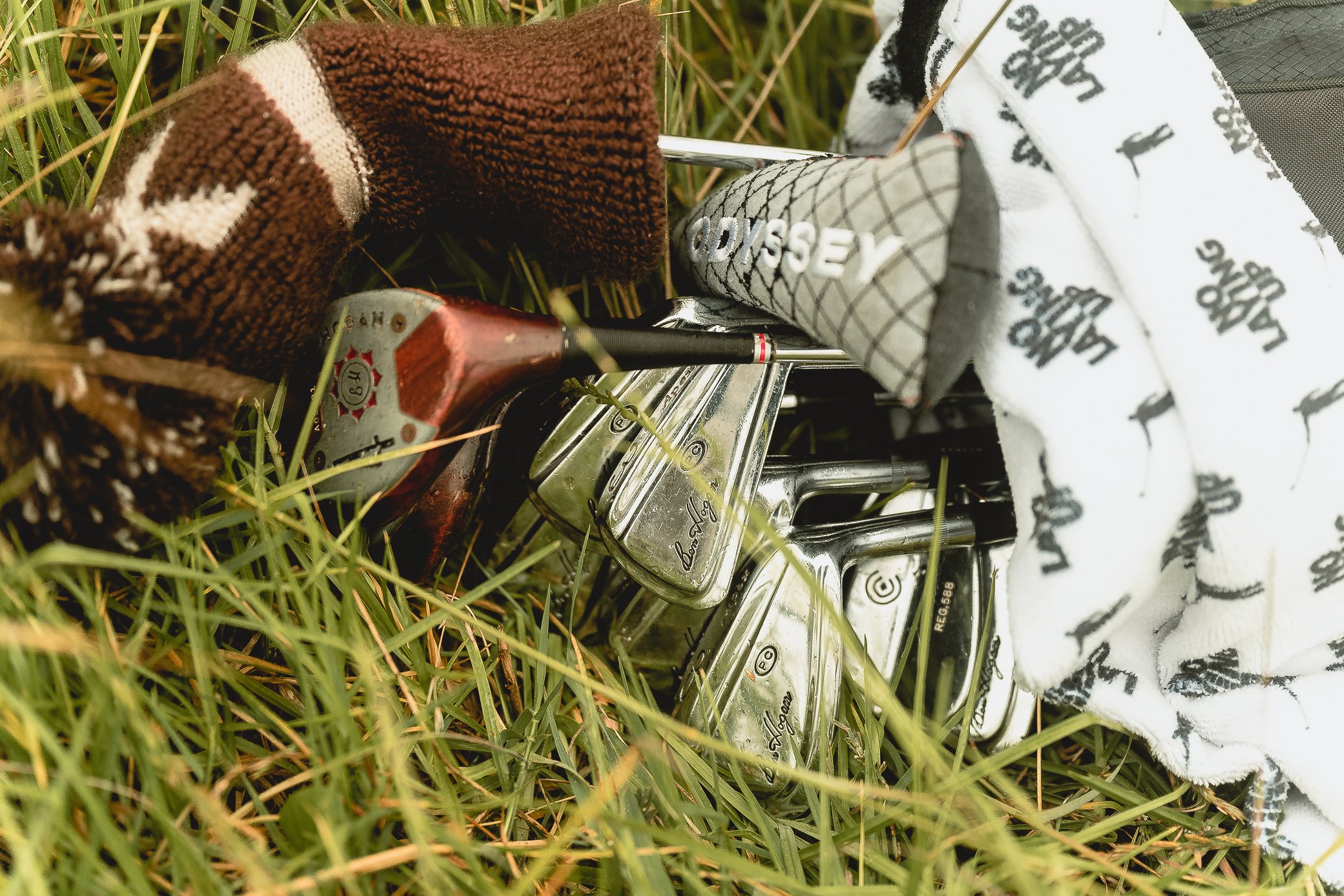
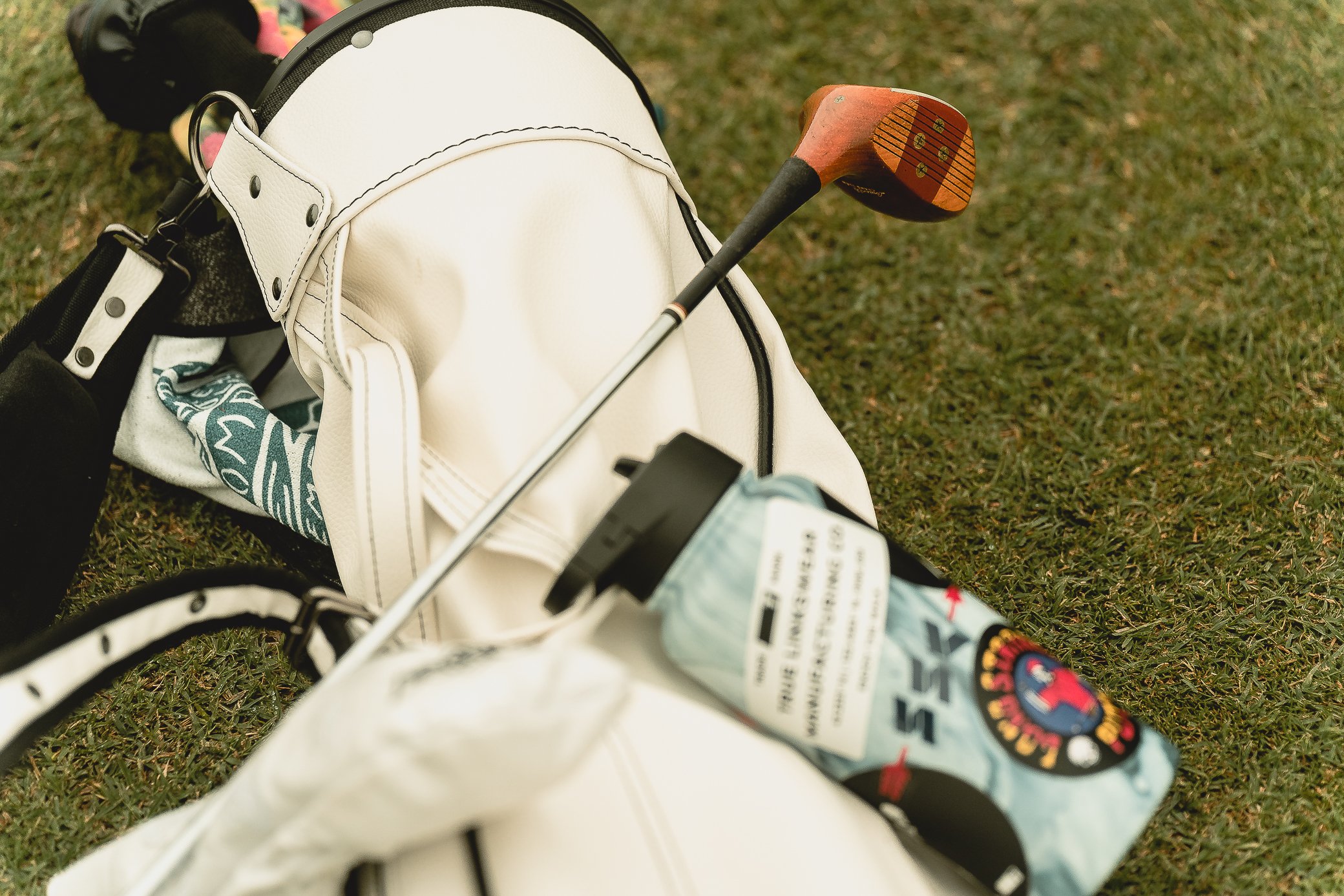
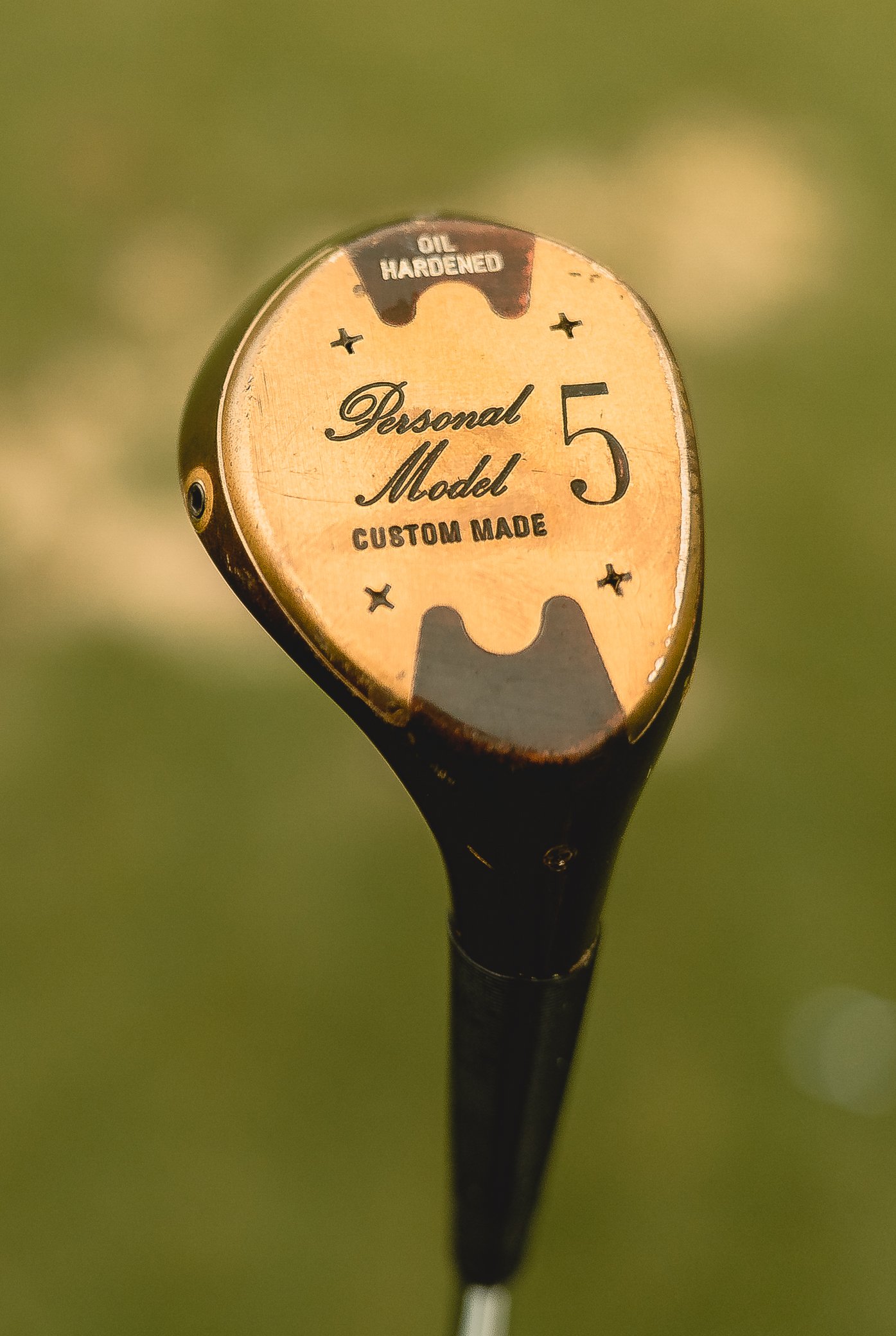
I sorted through boxes of holiday decorations before I found what I was looking for. Sitting in my garage were three mid-70s Hogan persimmon woods. The clubs were gifted to my late-father and used as decor in his “I’d Rather Be” room. The room consisted of pictures and trinkets related to activities he would “rather be” doing than working. Beside the woods, lay a set of late ‘80s Hogan Apex blades purchased during a boredom-induced shopping spree. I rounded out the bag with the oldest putter I owned, a heel-shafted Odyssey 882. I threw a handful of golf balls into a carry bag and spent the remainder of the evening collecting everything I needed for the round. The possibilities of the next day’s outcome rotated in my mind like the mobile above a baby’s crib as I drifted to sleep.
The next morning’s 5:00 am alarm nudged me gently, a stark contrast to the usual battle between sleep and the obligation to show up. The 15-minute drive to Olivas Links felt quicker than usual, likely expedited by the excitement of the unknown. Troy unveiled his clubs on the practice green. His bag consisted of Titleist DCI irons, a no-name persimmon driver, and a “Personal Model” 5-wood. He brought modern Cleveland wedges and a Scotty Cameron putter he acquired via a home repair barter.
Olivas Links plays a shade under 6,100 yards from the white tees. The course is anchored at sea level and sits less than a mile from Ventura Harbor. The links influence is modest at sunrise. The offshore winds remain tame until late morning, and the fairways lack the brown hue of a traditional links course. Runoffs and tightly mown areas surround the greens, but they are more likely to plug than kick your ball forward. If the links designation feels inorganic, it reflects the property’s history. The course was originally designed as a parkland track and operated under the name Olivas Park until the early 2000s. Thereafter, the city-owned course underwent a drastic redesign at the hands of Forrest Richardson.
Richardson capitalized on the sandy base and brought movement reminiscent of the nearby dunes. The fairways remain wide enough for public play but are outlined by a punishing “native area” capable of swallowing golf balls by the sleeve. Strategically placed bunkers challenge confident players off the tee. A more timid golfer can submit to laying up, but they will be tasked with executing a more precise second shot. Ricardson created tiers and shelves on the greens that reward and punish approach shots appropriately. Missing the putting surface imposes a dilemma: the precise strike of a lofted club or carefully measured force applied to a ball that remains on the ground.
Our playing partner, Brooke, remained committed to the ground game. A third-degree master mason of the Texas Wedge, Brooke never shied away from the putter. If his rangefinder measured anything less than 65 yards, the putter was in play. I’ve witnessed him roll the ball through rough, between bunkers, and across cart paths with brazen confidence. Fear only enters the conversation when a wedge is forced into his hands.
I felt a return of anxiety as I approached the first tee. My internal dialogue accelerated, and I questioned my ability to hit a persimmon wood. How could I commit to shunning 40 years of club technology? Would I embarrass myself for the next four hours? On cue, Troy leaned over and said, “Let’s go have some fun.” There was that word again, “fun.” Instead of generating confusion, it triggered a memory. One of playing youth sports — a time when no one cared about the final score and I was wholly consumed by the moment. The feeling was nostalgic but quickly fading. I needed a trigger to remain present, a reminder to keep things light-hearted and instinctual. I remembered an old coach’s cliché: See ball, hit ball.
I placed my ball on a tee and wondered, “Can you ‘idiot mark’ a persimmon?” Before I took the club back, I recalled the day’s mantra: See ball, hit ball. In an instant, it was over. The ball contacted the right center of the clubface and faded down the middle of the fairway.
I heard a voice yell from the back of the tee box,
“BEN. FREAKING. HOGAN!”
The author of the comment was the fourth member of our group, a man affectionately known as “The Monkey.” The genesis of his name dated back to a yard sale decades earlier. While browsing odds and ends, a friend located a portrait of a monkey dressed in a ruffled shirt and vest, holding a boiled egg on a spoon. The primate’s facial expressions bore an uncanny resemblance to the man who later assumed the nickname. Golf arrived later in life for The Monkey. He was a mere five years into his addiction and lacked the consistency to regularly break 90. He overcame any talent deficiencies by being the greatest hang. It was impossible to have a bad time around him. The Monkey always provided self-deprecating comedic relief and unwavering support. However, like his primate brethren, he could be impulsive.
During the winter of 2022, he purchased a new TaylorMade driver on a whim. The club’s maiden voyage would also be its last. The Monkey hit three consecutive tee shots into Olivas’ native area, carding double bogeys or worse each occasion. The lackluster performance drove him into a deep, craft beer-fueled depression. In his most vulnerable state, Facebook ads declaring Ben Hogan drivers as the straightest on the market targeted him. Six IPAs and four clicks later, The Monkey was the owner of a driver manufactured by a company that would cease to exist a few months later. Whether by pride or obligation, his Hogan driver remained in the bag.
Troy showed none of my clouded thinking on the first tee. He smirked as he waggled the club, each pass measuring the flex of the steel-shafted driver. The ball traveled low and left off the face. It was the type of snap hook that generates immediate panic. But there was no evidence of that. Troy’s smile widened. It was as big as any I had seen after a 300-yard drive or holed eagle putt. He walked enthusiastically to his ball and chose a 2-iron for his second shot. He struck it purely and in perfect rhythm.
For this round, I abandoned technology. No rangefinders and no GPS yardage on my phone. I walked off approximately 87 yards to a front-right flag from the sprinkler-mounted markers. The leading edge caught the turf just before impact, causing the ball to fly five yards short of my intended target. It released onto the green and stopped eight feet beneath the hole. I crouched behind my ball and thought about the triumph of starting my day with a birdie. I took a moment to shake off any delusions of grandeur. Today was about rediscovering fun, not scoring. Just outside right with pace. The putter metronomed back and through. I turned my head and watched as the ball disappeared over the front edge of the cup. I felt a rush of excitement. It was not because of the score, but in spite of it. The warm feeling coursing through my veins was the byproduct of friends collectively laughing at the absurdity. The joy was not the result of surpassing expectations; it was the absence of them.
By the 4th hole, the marine layer lifted. The departing haze revealed plentiful sunshine and a brand of temperate morning weather that forces you to justify the cost of living in Southern California. The Monkey replaced the empty beer in his koozie while Brooke scrolled through a collection of ‘80s music on his phone. After five holes, I remained one-under par.
It’s hard to ignore the peril associated with missing the 6th fairway. Trees on the left provide visual intimidation and give the illusion of a narrow landing area. Although the left side of the fairway is generous, a lone tree guards view of the green like Dikembe Mutombo in the paint. Native area traces the right side. Even a modest recovery shot can be complicated by two obtrusive trees punctuating the end of the right rough. Normally, the 6th hole earns its title as the second handicap. For two guys with vintage clubs, it was a pair of routine pars.
Throughout the front nine, Troy and I familiarized ourselves with our clubs. The growing pains included missed fairways and flirtations with the hosel. For each good shot, we looked at each other with childlike giddiness. With every bad shot came a light-hearted shrug and a chuckle at the humor of the day’s task. Troy’s iron play was proficient, at times bordering on artful. His ball flew through a mid-level window with repetition and rarely drifted from the perimeter of the green. He struggled with the putter for seven holes before realizing the grip was canted to the left. He accepted the equipment defect as another variable of the round and moved on without complaint.
On the 9th hole, Troy laced a driver past the cross bunker. The ball fed down the slope and settled in a collection area near the end of the fairway. He would have to navigate a two-tiered green, the upper-level sloping significantly downward towards the back, with the sides folding inward like a Pringle. He flighted a wedge into a five mile-per-hour headwind. It pitched hole-high, ten feet left. Crooked, but not offline, the Scotty Cameron delivered its first birdie of the day. I recovered from the right fairway bunker and salvaged a two-putt par from the front of the green.
At the halfway mark, two facts about Olivas Links became clear. First, the course was in exceptional shape. Lush fairways may seem counterintuitive to links golf, but healthy turf and pure greens are a welcome surprise at a public golf course. Second, Olivas is a popular destination. By mid-morning, the parking lot was full. Players awaiting their tee times occupied the practice areas. On a typical weekend, the course has a full slate of reservations from sunrise until late afternoon. We’re all familiar with the rise in golf’s popularity during and after the COVID-19 pandemic. Players flocked to golf courses after the implementation of social distancing and the easing of stay-at-home orders. However, a second wave of players arrived at Olivas Links this winter.
Buenaventura Golf Course lies less than three miles east of Olivas Links, with both bordering the Santa Clara River. Torrential rains doused Southern California in early January and drowned Ventura’s namesake course. The influx of water tore away several greens and deposited hundreds of tons of mud and debris. The river reached the highest point of the property, damaging Buenaventura’s restaurant and pro shop. As of July of 2023, the course remains closed, and its restoration likely hinges on the approval for federal disaster funding.
Somehow, the staff at Olivas Links manage the demand of two courses with one property. Players accustomed to extravagant clubhouses and locker rooms may experience culture shock upon first visit. The Pro Shop is a double-wide trailer situated in the northwest corner of the parking lot. It houses the essential food and beverage needs, a refrigerator stocked with cold beer and a hot dog roller to satisfy the occasional “glizzy” craving. In place of a locker room, you’ll find a second trailer with “temporary” bathroom facilities. Yes, there are flushable toilets and running water.
Whether by conscious decision or a result of frugal city spending, the lack of infrastructure spawned an underdog mentality. The staff are resourceful, approachable, and take ownership. At its core, Olivas is a versatile golf course that caters to players of all skill levels. It is a public arena where the Senior Women’s Club comfortably hosts their monthly event on Saturday before the agronomy crew moves the tee markers back for Tuesday’s city championship. Olivas serves as a reminder that without an identity, a golf course is nothing more than a set of landmarks and predetermined targets. With one, it becomes a living, breathing representation of the community it serves.
The atmosphere at the turn was as light as the onshore breeze. The sun wicked away the morning’s dew and there was a subtle shine to the greens. Approaching the 10th tee, we turned to face south. The remainder of the morning’s fog hovered over the riverbed, contrasting the tan and yellow shades of bamboo. My mind was free from swing thoughts and irritation... and I was one-under par.
The back nine played 200 yards longer than the front and presented a tougher challenge. Water hazards posed trouble on the 11th, 12th, 13th, and 16th holes. On the dogleg right par-4 11th, Troy benched a temperamental driver for a more predictable 2-iron. The ball flew on a rope, avoiding out of bounds left, a water hazard right, and a bunker long of the fairway. Brooke and The Monkey ribbed me for playing a 3-iron, accusing me of distance-related hubris and undercutting the greatness of Troy’s shot. I struck the lower third of the clubface positioning my ball 30 yards behind Troy’s. With 160 yards to the green, I found my purest strike of the day. The ball flew towards the elevated green and perched on a mound 10 yards behind the flag. We walked away satisfied with matching pars.
Holes 13 and 14 guide players west. On this day, the par-3 13th played 175 yards facing into a two-club headwind. Again, we were presented a multi-tiered green sloping back to front. This time, the pin was in the back right corner, guarded by a mogul. The Monkey made his best swing of the day, landing 6-iron 12 feet left of the flag. Birdie opportunities were rare for him. He was unfamiliar with life under par, and often accused of “being scared of greatness.” Inevitably, he juiced his first putt five feet past the hole and three-putted for bogey. After a tentative swing, I missed the green pin-high right. My chip was downhill and short-sided. Devoid of a 60-degree, I opened the face on my old-fashioned sand wedge and prayed to the gods of bounce. The first hop landed a foot short of the collar, momentarily checking with spin. The second rested three feet short of the hole. The Odyssey rolled another clutch putt to save par and remain one-under.
On the tee box of the par-5 14th, Troy launched his second spectacular drive of the day. He posed in-frame, slowly recoiling from his follow-through. He quite literally hit one on the screws. He commented, “Isn’t it such a different feeling when you catch one?” We continued the conversation up the fairway until I broke right to look for my ball in the rough. Troy considered his options. He had 240 yards into a 15 mile-per-hour wind. A set of bunkers sat 40 yards short of the green. His 2-iron had been automatic all round, but what about the 5-wood? It was the only persimmon he hadn’t hit thus far. The curiosity alone made it the right club. For the second consecutive swing, he the found the dead-center of the clubface. Before the ball landed near the green,
Troy glanced at me with a look that shouted, “Did you see that?”
Brooke’s frenetic ball striking embodied life as a nine-handicap. He played a power fade off the 14th tee and landed in the right fairway. He followed with a duffed hybrid that traveled 10 yards. Fear of making a big number on the par-5 influenced him to lay up to 80 yards. His fourth shot required the use of a wedge. With his nemesis in hand, Brooke flared his approach to the opposite tier of the green. As was so often the case, he buried a 35-foot putt for par.
The wind was once again at our backs as we faced east on the 15th tee. The dogleg par-4 reaches the southwest boundary of the property. It sports out-of-bounds along the right side until a 45-degree turn reveals the green. Troy hit 5-wood again, but this time his contact leaned toward the toe of the club. A flustered expression overtook his face as he watched the ball carry into the right rough. Blocked by trees and a fence, he had no choice but to lay up. I had 114 yards into a front-and-center pin location. The wind blew downward consistently. I estimated that a three-quarters pitching wedge would ride the breeze to hole-high. The ball reached its apex before falling out of the sky like there was a sudden doubling in gravity. It spun off the green, leaving 16 feet uphill for birdie. Two putts from the fringe secured my four and an even par round through 15 holes.
The 16th at Olivas Links is ripe for debate as either the course’s best or worst hole. Your stance will likely be decided by your score. From the blue tees, it’s a 460-yard par-4. The prevailing wind shrinks the overall length by a club. Conversely, it also narrows the landing area. Miss the fairway to the left, and you’ll be dropping from the water hazard. Hit it too far right, and you’re declaring your ball out of bounds while playing your third shot from the tee.
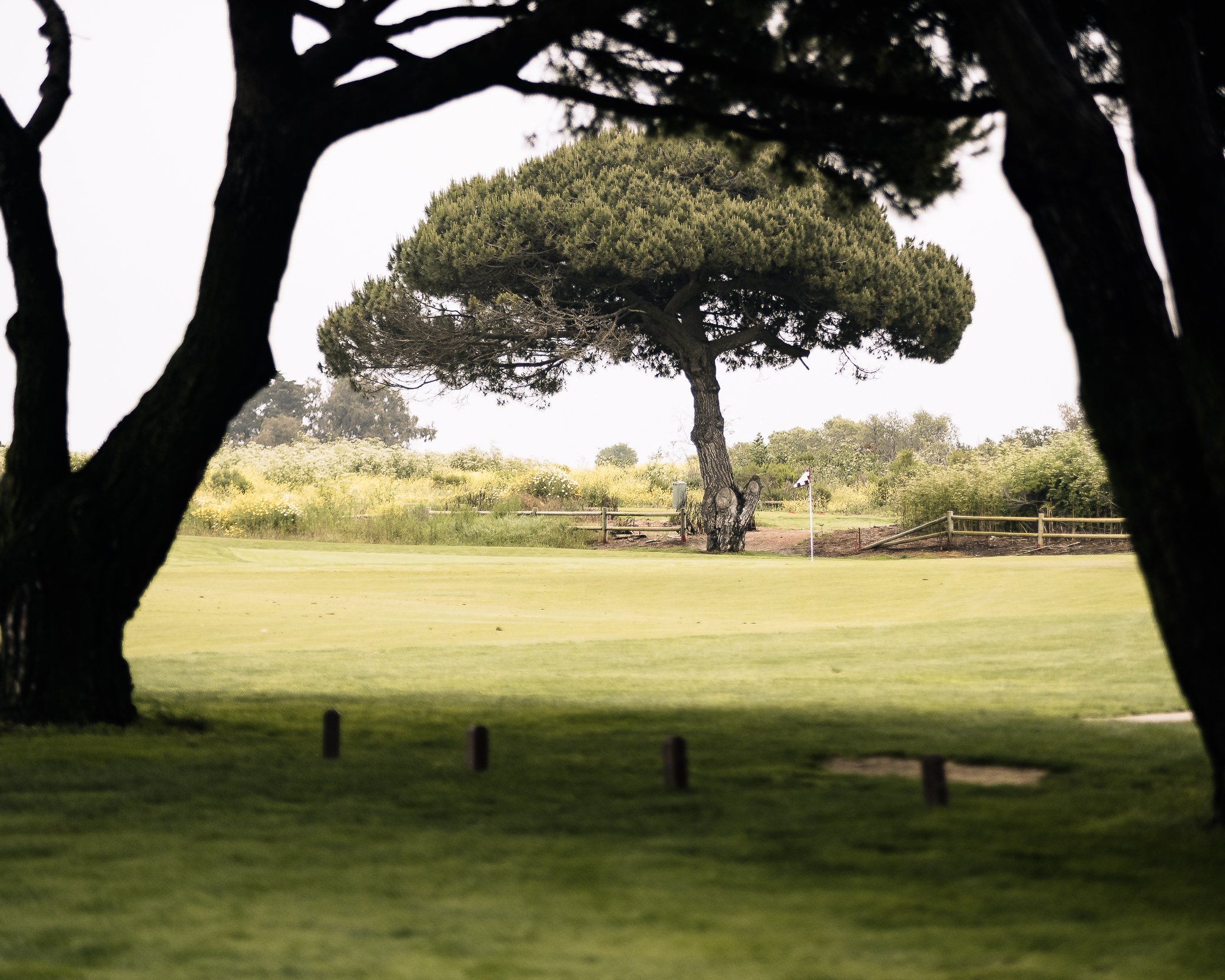
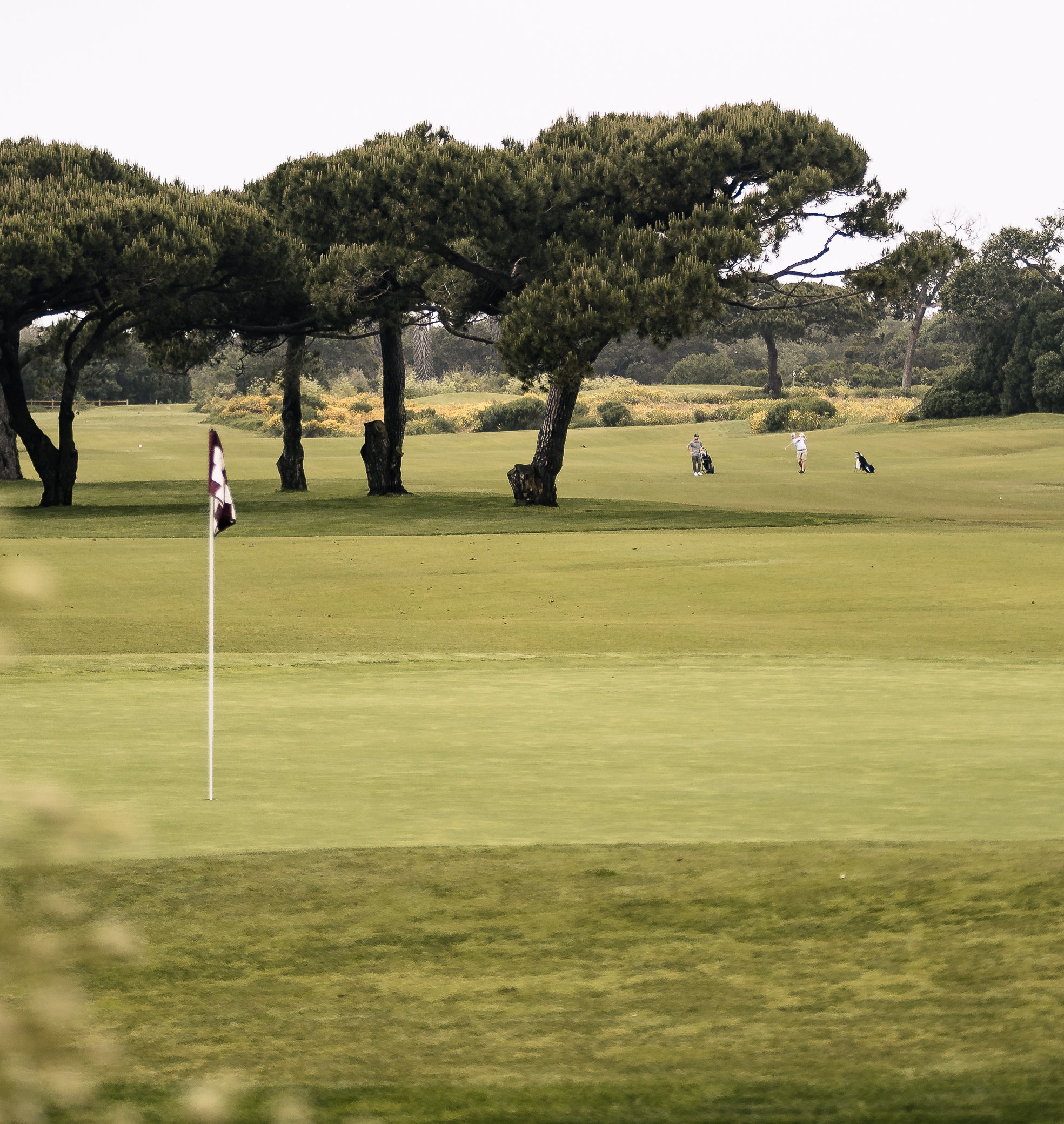
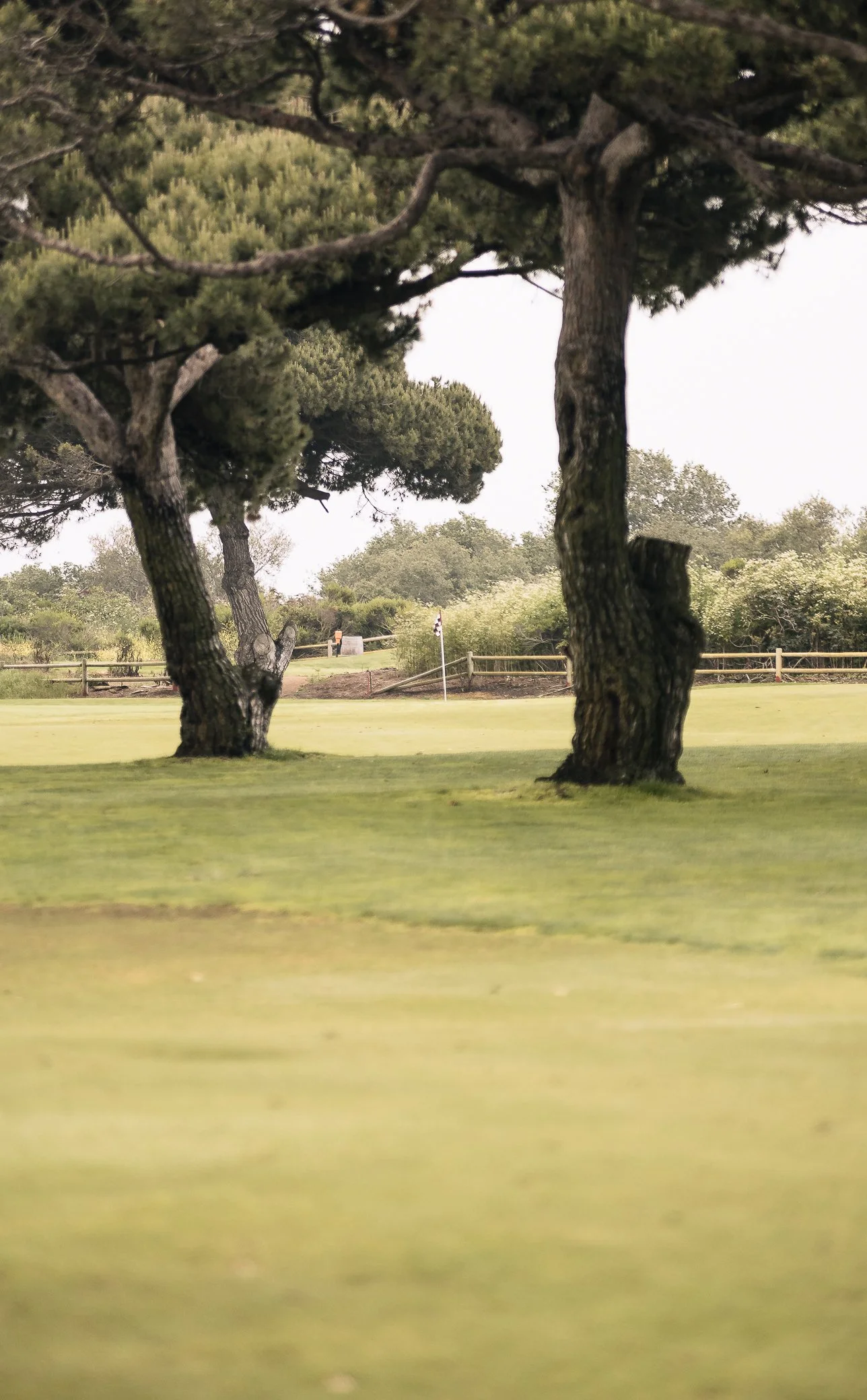
What about laying up? Interesting notion. Short left, there’s a trio of bunkers. Short right, there’s a gathering of trees preventing a stock approach shot. Hit a perfect layup, and you’ll have no less than 210 yards into the firmest green on the course. The best way to play 16? Hit a drive over 280 yards that drifts softly left to right, away from the water. Seems unlikely, right? Well, so is making par.
We had a substantial advantage playing the white tees. The hole was only 440 yards. Troy ignored any scar tissue from previous rounds and chose driver. His tee ball was not just accurate; it was long. His drive ran parallel to the water and landed in the middle of the fairway. By our guess, it carried 270 yards.
Troy’s tee shot on 16 was a bold decision overshadowed by a bolder one. Brooke’s drive found the right tree line. He was stuck navigating a narrow alley. His second shot missed the overhanging branches, but his ball was slowed by the rough and stopped short of the green. He had 65 yards to the hole from a clean fairway lie. Without hesitation, Brooke pulled the putter. The calculations required to navigate three cuts of grass, two slope reads, and one putter stroke is beyond comprehension. Even for a short-game demigod like Brooke, the likelihood of success boiled down to a roll of the dice. His putt trundled along the fairway, hopped twice before the apron, and settled on the fringe between two sprinkler heads. Snake Eyes.
I missed right off the tee and joined Brooke in the arbor corridor. A punch 7-iron returned my second shot to the fairway. Faced with 180 yards, I attempted a high cut 4-iron around the trees. I watched as the ball flew straight and settled 30 feet left of the pin. A three-putt led to a deflating double bogey. I was now two-over-par. In recent months, a score like that signaled a Tin Cup-esque meltdown and a symphony of whining violins. But today, with this group of friends, great course conditions, and an assortment of old clubs, it didn’t matter. There were two holes left, and the experience of the last three and a half hours was too valuable to ruin.
The 17th hole is a short par-3 protected by a large front bunker. A severe spine bisects the left and right sides of the surface. It functioned as the perfect funnel for today’s pin. I hit a crisp wedge that landed just left of the slope and careened behind the hole. From seven feet, I repeated, See ball, hit ball. Guided by my smoothest putter stroke of the day, another birdie fell. I was one-over with the par-5 18th remaining.
Troy finished with style on the last tee. He split the fairway with driver and avoided a water hazard left and a fairway bunker right. He peppered a 5-wood to the front of the green from 230 yards. My drive missed the fairway and rested in the right rough. I played a 3-wood on approach but found the right, greenside bunker. I smiled as we walked toward the last green and reflected on the day’s journey. Filled with a sense of appreciation, a truth became apparent. The decision to play persimmon woods and antique irons was not an experiment. Rather, it was an exercise in forced perspective, both on my understanding of Olivas Links and my relationship with golf.
From the bunker, I pitched out to 15 feet. Troy chipped his third shot to four feet. He ended his round with a successful birdie putt and a trio of high-fives. I studied my putt from every angle and hoped to wrap an even-par bow on the round. The ball tracked for 14 feet but snapped left just before the hole. It was a tap-in par and a one-over round of 73.
Troy replaced the flag for the final time, and we removed our caps to shake hands with our playing partners. As we walked off the 18th green, there were no scorecards to sign or scores to post. In their place were laughs, statements of gratitude and the understanding that golf, in its purest form, is the intersection of sport, camaraderie…
















